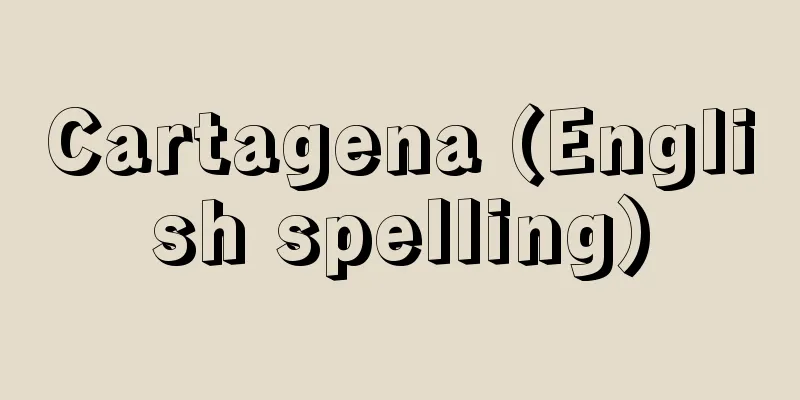Cartagena (English spelling)

The capital of the state of Bolivar in northwestern Colombia. A port city facing Cartagena Bay, an inlet of the Caribbean Sea. Founded by the Spanish in 1533, it prospered as a transportation base for transporting gold and other goods produced in northern South America to Spain from the mid-16th century. To protect the city from pirate attacks, fortifications were built early on, including fortresses such as San Felipe de Barajas and San Fernando, as well as sturdy city walls. Communication with the inland was mainly via the Magdalena River in the west, but by the mid-17th century, the Dique Canal was opened, connecting the city to Calamar on the Magdalena River. In 1811, the city declared independence from Spain early on, and maintained its position as the main port in the region throughout the subsequent period of turmoil, but by the 1840s, both its population and trade volume began to decline, and Barranquilla, near the mouth of the Magdalena River, developed as the main port instead. At the end of the 19th century, a railway was built between the city and Calamar, and trade recovered somewhat. In the 20th century, the development of large-scale oil fields along the Magdalena River began, and in 1926, a pipeline was laid from Barrancabermeja on the middle Magdalena River to Cartagena Bay, and the city began to develop again, becoming Colombia's main oil shipping port. Industry also developed, producing sugar, tobacco, cosmetics, textiles, and leather products. The city is centered on the old town, surrounded by a city wall that stretches across the peninsula and Getsemani Island, and spreads toward the islands of Manga and Manzanillo in the south and the mainland in the east. In the old town, there are many old buildings such as the magnificent cathedral, San Pedro Clavel Basilica, the Inquisition, and the University of Cartagena (1824), as well as narrow streets and squares in the Spanish style. In 1984, the port and the fortress were registered as cultural heritage of the World Heritage Sites. The main road connecting Barranquilla and Medellin runs through the city. Population: 522,318 (1985). Cartagena |
コロンビア北西部,ボリバル州の州都。カリブ海の入江,カルタヘナ湾に臨む港湾都市。 1533年スペイン人により建設され,16世紀半ば以降南アメリカ北部で産する金その他の物資をスペイン本国へ運ぶための輸送基地となり,繁栄。海賊などの襲撃から市を守るため,早くから要塞化が進められ,サンフェリペデバラハス,サンフェルナンドなどの要塞や堅固な市壁が建設された。内陸部との連絡はおもに西のマグダレナ川によったが,17世紀半ばまでには市とマグダレナ川沿岸のカラマルを結ぶディケ運河が開通。 1811年いち早くスペインからの独立を宣言,その後の混乱期を通じてこの地域の主要港としての地位を保ったが,1840年代までに人口,貿易量ともに減少しはじめ,代わってマグダレナ川河口近くのバランキヤが主要港として発展。 19世紀末カラマルとの間に鉄道が通じて貿易がやや回復。 20世紀に入ってマグダレナ川沿岸の大規模な油田地帯の開発が始まり,1926年マグダレナ川中流部沿岸のバランカベルメハからカルタヘナ湾までパイプラインが通じ,再び発展しはじめ,コロンビアの主要な石油積出港となった。工業も発達し,砂糖,タバコ,化粧品,織物,皮革製品などを製造。市街は半島部とヘツェマニ島にかけて広がる市壁に囲まれた旧市街を中心に,南のマンガ,マンサニヨなどの島や東の本土方面へ向かって広がっている。旧市街にはスペイン風の細い街路や広場などとともに,華麗な大聖堂,サンペドロクラベル聖堂,宗教裁判所,カルタヘナ大学 (1824) などの古い建築物が多数残っており,1984年港,要塞とともに世界遺産の文化遺産に登録。バランキヤとメデリンを結ぶ幹線道路が通る。人口 52万 2318 (1985) 。
カルタヘナ
|
<<: Cardamom - karudamon (English spelling) cardamon
>>: Cardano - Girolamo Cardano
Recommend
traumatic acid
… In 1927, B. Wehnelt, a student of Haberland, fo...
Fiscal Investment and Loan Program - zaiseitoyuushikeikaku
This is the management plan for FILP, which is the...
Ikeda charcoal
〘Noun〙 High-quality charcoal burned in Nose Distri...
Needle Memorial Service - Harikuyo
An event to take a break from needlework and to o...
Toyosaka [city] - Toyosaka
An old city on the right bank of the downstream Ag...
Suicide egoïste (English spelling)
…In his book “Suicide: An Essay on Sociology” (18...
Morocco jouyi (English spelling) Moroccojouyi
…[Morizumi Nakamura]. … *Some of the terminology ...
Diwan al-mashriq (English spelling)
...During the Abbasid Caliphate (750-1258), the c...
Wolker, J.
…Other prose writers of this period include Karel...
Academic Words - Gakushikigo
… Finally, the majority of French vocabulary is d...
ETA (Spanish faction) (English spelling) ETA
…Official name: Estado españolArea: 504,782 km2Po...
diphthong
…cart[kːt]〈car〉. (7) Diphthongs A syllable is for...
Ienaga lawsuit
In a narrow sense, it refers to measures taken by...
SCSD - SCSD
...Such parts of a building are called building s...
Masakatsu Abe
1541-1600 A samurai from the Oda-Toyotomi period....









